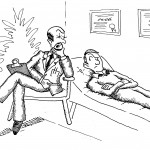
There is a pervasive myth that “body language” experts such as those portrayed in TV shows “The Mentalist” and “Lie To Me” can read non-verbal communication with such deftness as to almost know what others are thinking. The truth is far from the case, but large amounts of information are gathered during our dealings with others from their non-verbal cues.
We may also fall prey to our own limitations in perceiving and reading of these cues, with all of the social embarrassment that this can cause. Many studies are beginning to describe some of the neural underpinnings of this, particularly in the study of autism spectrum disorders, with the view that “mirror neurones” fire in concert with our observations of others’ movements (thereby allowing us to perhaps make inferences about their intent, emotional state and future actions).
A recent observational study by Lavelle et al looks at the non-verbal interactions of people with a diagnosis of schizophrenia and their psychiatrists during consultations (Lavelle et al, 2014). They highlight some of the previous work in this area, which has mainly focussed on the non-verbal profile of patients; going all the way back to the 1940’s concept of “Praecox-Gefühl” (pray-cox-ge-fool) which suggested that there were characteristic observations of behaviour that differed in patients compared to those without a diagnosis.
In their research, Lavelle et al found a dearth of information studying the variability of behaviour over time and the effects within the therapeutic relationship; they therefore decided that their study should also seek to encompass these areas. This seems eminently sensible given that all interpersonal interactions require at least two people, and the behaviour of one may be altered by the behaviour of the other.

If you believe the TV shows, psychiatrists and psychologists are a heady mix of hypnotist, sage and sex-god. In reality, this is not necessarily the case.
Methods
Essentially this study looks at the interaction of patients and psychiatrists in videoed consultations using ethological analysis to examine three separate two minute intervals. Their aims were to answer the following:
- Does patient’s non-verbal behaviour change during a consultation?
- Is there an association between the non-verbal behaviour of the patient and the psychiatrist?
- Can patient groups be identified based on their non-verbal behaviour?
- Is the non-verbal behaviour displayed during the consultation associated with the patients’ symptoms, experience of the communication and the quality of the therapeutic relationship?
In order to do this 40 outpatient clinic appointments were recorded, covering 40 different patients seeing 17 different psychiatrists. To be eligible participants needed to be between 18 and 65 and to have a diagnosis of schizophrenia or schizoaffective disorder. They gave consent for video recordings to be taken and used for research, and participated in an interview with a researcher after their consultation with the psychiatrist.
Patients were recruited from the waiting rooms of clinics and the consultations took place in the normal clinic setting, albeit with a video camera set up. Afterwards the participants completed questionnaires to collect their demographic data, symptom severity with PANSS (Positive and Negative Syndrome Scale), a Patient Experience Questionnaire, and a rating of the therapeutic alliance (Helping Alliance Scale – client version (HAS)). The clinicians were also asked to complete the Helping Alliance Scale – therapist version.
To assess the interactions within the consultation, 2 psychiatrists who were independent of the patients’ care watched the silent footage and used a modified Ethological Coding System for Interviews or ECIS (a 13 item system recording face, hand and head movements) at three fixed two minute times. The full ECIS consists of 37 items and looks to evaluate whether patterns of behaviour are absent, displayed once or displayed more than once during 30 second sampling periods, and looks at several domains: gaze, gesture, pro-social behaviour, flight behaviour, assertion, displacement and relaxation. The cut-down version was used in this case due to the quality of the video recordings, which due to the variable size of interview rooms and siting of cameras sometimes did not include a picture of the whole of the patient.
Statistical measures were then applied to the data to look at changes in behaviour of the patient and the psychiatrist over time, and to see if behaviours in one were associated with behaviour in the other. Groups of patients by their behaviour were also identified using a form of clustering analysis. Mixed models analyses were employed to seek differences between clusters based on the different non-verbal categories assessed by the ECIS. All other measures (e.g. demographic data and HAS scores) were compared using chi-squared or Mann-Whitney U tests.

The study involved 40 outpatients, with a diagnosis of schizophrenia or schizoaffective disorder, being videoed whilst in consultation with their psychiatrist (17 different psychiatrists in total).
Results
There were a mixture of male and female patients and psychiatrists, from a range of racial backgrounds. Mean illness duration was 18.7 years (range 2-41) and patients had spent a mean of 31.9 weeks in hospital during their illness (range 0-130 weeks). Overall patient symptom scores were variable with wide ranges on each of the three branches of the PANSS. Patients rated the therapeutic alliance lower than that given by the psychiatrist 8.32 (SD=2.12; range 0.2-10) versus 9 (SD=7.23; range 0.8-9).
With regard to non-verbal behaviour, patient behaviours did not significantly change during the interviews, but psychiatrists showed significantly fewer flight behaviours as time went on (p<0.01). Where patients showed more pro-social behaviours (smiling, friendliness, submissive nodding, appeasement) so too did the psychiatrist, who then also showed less flight behaviours. Grouping of patients based on their non-verbal interactions led to two clusters one of 25 patients showing more pro-social behaviours, and one of 15 patients showing more flight behaviours (looking down, looking away, freezing, avoiding).
Comparing these two groups revealed that psychiatrists showed more pro-social behaviour when interacting with the pro-social group, and that these patients had lower PANSS scores for positive and general symptoms. Therapeutic relationship and communication was rated higher by this group when considering the interactions with their psychiatrist.

The authors concluded that patients’ non-verbal behaviour is associated both with the behaviour of their psychiatrist and the quality of the therapeutic relationship.
Discussion
Lavelle and her colleagues have built on earlier work looking at patient non-verbal behaviours and extended it to look at the interactions of both psychiatrist and patient within a consultation. They sum up their findings thus:
- Patients’ behaviours don’t change during the interview, but psychiatrists become less flighty.
- Two groups of patients emerged, one showing pro-social behaviours and the other showing more flight behaviours.
- Pro-social patients had more pro-social behaviours displayed by their psychiatrists.
- Pro-social patients were more likely to be working, had fewer symptoms and rated the encounter with their psychiatrist more positively.
The authors suggest several things from these results, including that future studies could use one ECIS measurement for patients as their behaviours are stable over the course of the interview. They also suggest that the reduction in flight behaviours in the psychiatrists may be due to the clinicians’ sensitivities to avoid being too pro-social at the beginning of an interview so as to invite interaction without being overwhelming.
I wonder if it is perhaps that the beginning of a consultation is usually more formal and that it takes time to gauge the level to pitch things with individual patients; or that once rapport is established psychiatrists are likely to mirror their patients’ body language in order to promote the interaction. The authors touch on this point and suggest that clinicians need to be aware that their own behaviours can be altered by their interactions, and to be mindful of this in avoidant patients.
The authors suggest that further studies could be conducted to assess whether non-verbal behaviours could be of use in developing more specific sub-groups within the schizophrenia diagnostic group, a group which is still highly heterogeneous. They also suggest the need for long-term studies looking at how the interactions between patients and psychiatrists are altered during the course of a therapeutic relationship over many months.

People with a diagnosis of schizophrenia are a hugely heterogeneous group and the authors suggest that further research into non-verbal behaviours may help develop more specific sub-groups.
Links
Lavelle M et al (2014) Non-verbal communication in meetings of psychiatrists and patients with schizophrenia (PDF). Acta Psychiatrica Scandinavica. Article first published online: 6 Aug 2014 DOI: 10.1111/acps.12319
Fogassi L and Rizzolatti G (2012) The Mirror Mechanism as Neurophysiological Basis for Action and Intention Understanding in Is Science Compatible with Free Will? Springer, New York; 2013 pp 117-134.
Gallese V, Rochat M And Berchio C (2013) The mirror mechanism and its potential role in autism spectrum disorder. Developmental Medicine & Child Neurology 55(1); pp 15-22. [PubMed abstract]

RT @Mental_Elf: It’s not what you say: Examining the non-verbal behaviours of psychiatrists and patients http://t.co/xStZJgRTy1
Examining the non-verbal behaviours of psychiatrists and their patients #psychology
http://t.co/eys36aWGEr
It’s not what you say: Examining the non-verbal behaviours of psychiatrists and patients: Chris Pell considers… http://t.co/QoHoc5ZoTU
It’s not what you say: Examining the non-verbal behaviours of psychiatrists and patients http://t.co/W84BQAT1ai via @sharethis
Holly Miller liked this on Facebook.
My latest blog for the @Mental_Elf on non-verbal communication in psychiatric consultations. Paper by Lavelle et al. http://t.co/gha6mGEh6d
@egosyntonically @anniecoops @Mental_Elf @neilwithnell may be of interest to students discussing and considering nvbl in mental health
@egosyntonically @Mental_Elf I like the description of psychiatrists becoming “less flighty”
Rose Lea liked this on Facebook.
The Mental Elf liked this on Facebook.
Today @egosyntonically on non-verbal behaviour & communication in meetings of psychiatrists & schizophrenia patients http://t.co/6ydlB6FzCi
Lisa Eden liked this on Facebook.
Will Convery liked this on Facebook.
Nicola Davies liked this on Facebook.
Sally Morton liked this on Facebook.
Lucy Riddett liked this on Facebook.
June Dunnett liked this on Facebook.
Observational study looks at patients’ non-verbal behaviour & associations with behaviour of their psychiatrist http://t.co/6ydlB6FzCi
Examining the non-verbal behaviours of psychiatrists and patients in consultations http://t.co/UQqFNlwDCD via @egosyntonically @Mental_Elf
Examining the non-verbal behaviours of psychiatrists & patients http://t.co/IKTS0Xrhb9
Study finds that patients’ behaviours don’t change during interview, but psychiatrists become less flighty http://t.co/6ydlB6FzCi
A nice little summary of Lavelle, et al. (2014) who investigated patient & psychiatrist body language http://t.co/w4aB66clWm via @Mental_Elf
Study finds that pro-social patients had more pro-social behaviours displayed by their psychiatrists http://t.co/6ydlB6FzCi
And, pro-social patients more likely to be working, had fewer symptoms & rated psychiatrist encounter more positively http://t.co/6ydlB6FzCi
Mental Elf: It’s not what you say: Examining the non-verbal behaviours of psychiatrists and patients http://t.co/2yfMhlYjmC
Sarah Steed liked this on Facebook.
Don’t miss – It’s not what you say: Examining the non-verbal behaviours of psychiatrists and patients http://t.co/6ydlB6FzCi
João Leal liked this on Facebook.
Jo Cole liked this on Facebook.
Really interesting blog on a study of nonverbal interaction between people with #schizophrenia & their #psychiatrists http://t.co/juFniLHDa8
Elaine Kelly liked this on Facebook.
Andrzej Tokarczyk liked this on Facebook.
It’s not what you say: Examining the non-verbal behaviours of psychiatrists & patients http://t.co/jm440l7Ji5 @Mental_Elf @egosyntonically